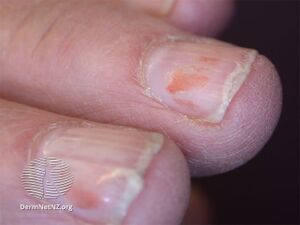Nail splitting
| Nail splitting | |
|---|---|
| Other names: Onychoschizia,[1] brittle nails[2] | |
 | |
| Specialty | Dermatology |
| Symptoms | Separation of layers of nail tips, los splits[1] |
| Causes | Frequent hand-washing, manicures, nail polish and remover, nail biting, repeated trauma[1] |
| Diagnostic method | Appearance, blood tests[1] |
| Prevention | Avoid repeated trauma[1] |
| Treatment | Apply moisturiser, discontinue nail cosmetics, supplement vitamin deficiencies[1] |
| Frequency | Common[1] |
Nail splitting, also known as onychoschizia, is splitting of the free-edged tip of the nail.[1] There is also often a longitudinal split in addition to the separation of keratin layers.[3]
Frequent hand-washing is the usual cause, but it is also part of normal ageing.[2] Manicures, nail polish and remover, nail biting, and repeated trauma such as typing, can contribute to nail splitting.[1] Dehydration likely plays a role.[4] Nutritional deficiencies that can result in nail splitting include iron, selenium, and zinc.[1] Some skin diseases such as psoriasis and lichen planus may feature such nails.[2]
Diagnosis is by its appearance, but sometimes blood tests are required to look for iron deficiency, thyroid problems, and kidney problems.[1]
Treatment is by discontinuing nail polish and applying moisturiser.[3] An acceptable alternative is gel nails.[3] Some favourable response has been reported with biotin, at a dose of 2.5mg daily for 6-months, if the person is deficient in vitamin B7.[1] It is not routinely given.[1]
It is common among women and occurs in almost a third of newborns.[3]
It also occurs in hooved animals such as horses.[5]
See also
References
- ↑ 1.00 1.01 1.02 1.03 1.04 1.05 1.06 1.07 1.08 1.09 1.10 1.11 1.12 Sloan, Brett (2022). "16. Multiple nail: nail splitting". In Waldman, Reid A.; Grant-Kels, Jane M. (eds.). Dermatology for the Primary Care Provider. Philadelphia: Elsevier. pp. 277–278. ISBN 978-0-323-71236-1. Archived from the original on 2023-07-01. Retrieved 2023-06-02.
- ↑ 2.0 2.1 2.2 Johnstone, Ronald B. (2017). "2. Diagnostic clues and "need-to-know" items". Weedon's Skin Pathology Essentials (2nd ed.). Elsevier. p. 31. ISBN 978-0-7020-6830-0. Archived from the original on 2023-07-01. Retrieved 2023-06-02.
- ↑ 3.0 3.1 3.2 3.3 James, William D.; Elston, Dirk; Treat, James R.; Rosenbach, Misha A.; Neuhaus, Isaac (2020). "33. Diseases of the skin appendages". Andrews' Diseases of the Skin: Clinical Dermatology (13th ed.). Edinburgh: Elsevier. p. 785. ISBN 978-0-323-54753-6. Archived from the original on 2023-06-30. Retrieved 2023-06-02.
- ↑ Saavedra, Arturo; Roh, Ellen K.; Mikailov, Anar (2023). "32.Disorders of the nail apparatus". Fitzpatrick's Color Atlas and Synopsis of Clinical Dermatology (9th ed.). New York: McGraw Hill Professional. pp. 849–872. ISBN 978-1-264-27801-5. Archived from the original on 2023-12-31. Retrieved 2024-01-18.
- ↑ Colombo, Victor E.; Gerber, Françoise; Bronhofer, Max; Floersheim, George L. (December 1990). "Treatment of brittle fingernails and onychoschizia with biotin: Scanning electron microscopy". Journal of the American Academy of Dermatology. 23 (6): 1127–1132. doi:10.1016/0190-9622(90)70345-i. PMID 2273113.